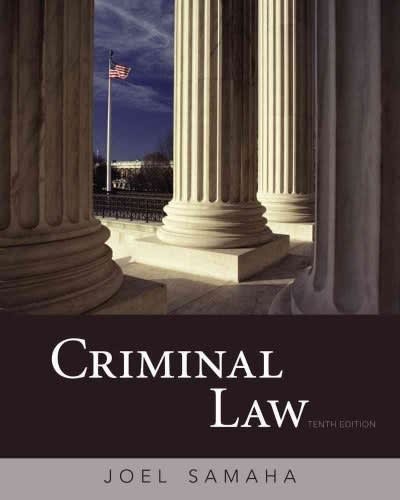Bernhard Goetz, the defendant, was indicted for criminal possession of a weapon, attempted murder, assault, and reckless
Question:
Bernhard Goetz, the defendant, was indicted for criminal possession of a weapon, attempted murder, assault, and reckless endangerment. The Supreme Court, Trial Term, New York County, dismissed the indictment and the People appealed. The Supreme Court, Appellate Division affirmed, and the People appealed. The Court of Appeals reversed and dismissed, and reinstated all the counts of the indictment. WACHTLER, CJ.
On Saturday afternoon, December 22, 1984, Troy Canty, Darryl Cabey, James Ramseur, and Barry Allen boarded an IRT express subway train in the Bronx and headed south toward lower Manhattan. The four youths rode together in the rear portion of the seventh car of the train. Two of the four, Ramseur and Cabey, had screwdrivers inside their coats, which they said were to be used to break into the coin boxes of video machines Bernhard Goetz boarded this subway train at 14th Street in Manhattan and sat down on a bench toward the rear section of the same car occupied by the four youths. Goetz was carrying an unlicensed .38-caliber pistol loaded with five rounds of ammunition in a waistband holster. The train left the 14th Street station and headed toward Chambers Street.
Canty approached Goetz, possibly with Allen beside him, and stated, “Give me five dollars.” Neither Canty nor any of the other youths displayed a weapon. Goetz responded by standing up, pulling out his handgun, and firing four shots in rapid succession. The first shot hit Canty in the chest; the second struck Allen in the back; the third went through Ramseur’s arm and into his left side; the fourth was fired at Cabey, who apparently was then standing in the corner of the car, but missed, deflecting instead off of a wall of the conductor’s cab.
After Goetz briefly surveyed the scene around him, he fired another shot at Cabey, who then was sitting on the end bench of the car. The bullet entered the rear of Cabey’s side and severed his spinal cord.
QUESTIONS
1. Consider the following:
a. New York tried Goetz for attempted murder and assault. The jury acquitted him of both charges. The jury said Goetz “was justified in shooting the four men with the silver-plated .38-caliber revolver he purchased in Florida.” They did convict him of illegal possession of a firearm, for which the Court sentenced Goetz to one year in jail.
b. Following the sentencing, Goetz told the Court: “This case is really more about the deterioration of society than it is about me. . . . I believe society needs to be protected from criminals.”
c. Criminal law professor George Fletcher followed the trial closely. After the acquittal, he commented: The facts of the Goetz case were relatively clear, but the primary fight was over the moral interpretation of the facts. . . . I am not in the slightest bit convinced that the four young men were about to mug Goetz. If he had said, “Listen buddy, I wish I had $5, but I don’t,” and walked to the other side of the car the chances are 60–40 nothing would have happened. Street-wise kids like that are more attuned to the costs of their behavior than Goetz was. (quoted in Roberts 1989) If Professor Fletcher is right, was Goetz justified in shooting?
2. Under what circumstances can people use deadly force, according to the New York statutes cited in the opinion?
3. Do you agree with those circumstances?
4. Would you add more? Remove some? Which ones? Why?
5. Were Goetz’s shots a preemptive strike? Retaliation? Necessary for self-protection? Explain.
Step by Step Answer:






